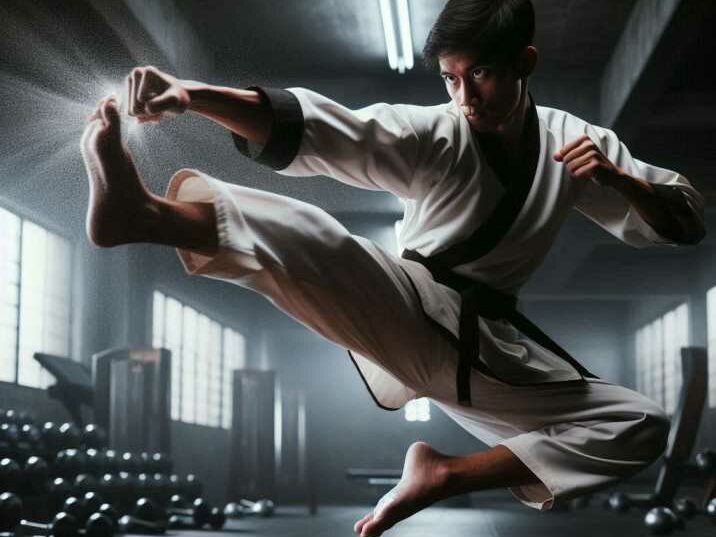Silat Training and Techniques: Mastering the Art of Self-Defense
Silat is an ancient martial art that has its roots in Southeast Asia. Renowned for its fluid movements and effective self-defense techniques, Silat combines elements of combat, self-discipline, and spiritual practice. This comprehensive guide delves into the silat training and techniques, offering insights into why this martial art has gained global recognition. Whether you’re a beginner or an experienced martial artist, understanding Silat’s nuances can enhance your skills and appreciation of martial arts as a whole.

What is Silat?
Table of Contents
Historical Background
Silat, often referred to as Pencak Silat in Indonesia, has a rich history that dates back centuries. Originating from the Malay Archipelago, including Malaysia, Indonesia, Singapore, and Brunei, Silat has been an integral part of the cultural and spiritual life of these regions. Originally developed for self-defense, Silat evolved through the ages, influenced by local traditions, religious practices, and foreign martial arts brought by traders and travelers.
Cultural Significance
Silat is more than just a martial art; it is a cultural treasure. In countries like Indonesia and Malaysia, Silat is often performed during cultural ceremonies, weddings, and national celebrations. It represents the spirit and identity of the people, showcasing their values of discipline, respect, and community.
Silat Training and Techniques
Benefits of Silat Training
Silat training offers numerous benefits beyond self-defense, making it a holistic practice for the body, mind, and spirit.
- Physical Fitness: Silat training improves cardiovascular health, increases flexibility, and enhances strength and stamina. The dynamic movements and intense drills provide a full-body workout.
- Mental Discipline: Practicing Silat requires focus and concentration, fostering mental clarity and discipline. The art encourages practitioners to develop a calm and focused mind, which can be beneficial in all aspects of life.
- Self-Defense Skills: Silat techniques are practical and effective for real-world self-defense situations. Practitioners learn to defend themselves against armed and unarmed attackers using punches, kicks, joint locks, and throws.
- Spiritual Growth: For many, Silat is a spiritual journey. The practice often incorporates meditation and breathing exercises, promoting inner peace and personal growth.
Core Silat Techniques
Basic Stances and Movements
Understanding the basic stances and movements is crucial for mastering Silat. These foundational elements form the basis of more advanced techniques and strategies.
- Kuda-Kuda (Horse Stance): A fundamental stance that provides balance and stability. The practitioner stands with feet shoulder-width apart, knees slightly bent, and weight evenly distributed.
- Langkah (Footwork): Silat’s unique footwork involves circular and linear movements to evade attacks and create openings for counterattacks. Practitioners learn to move fluidly, maintaining balance and control.
- Jurus (Forms): Jurus are pre-arranged sequences of movements that simulate combat scenarios. Practicing jurus helps students develop muscle memory, coordination, and technique precision.
Offensive Techniques
Silat incorporates a variety of offensive techniques designed to incapacitate opponents swiftly and efficiently.
- Punches and Strikes: Silat practitioners use punches, elbows, and open-hand strikes to target vital points on the body. Precision and speed are emphasized to maximize effectiveness.
- Kicks: Kicking techniques in Silat include high kicks, low sweeps, and spinning kicks. Flexibility and balance are essential for executing these powerful attacks.
- Knee and Elbow Strikes: These close-range techniques are used to strike vulnerable areas such as the ribs, chin, and temple. Knee and elbow strikes are devastating when delivered with proper technique.
Defensive Techniques
Defense is a critical aspect of Silat, with techniques designed to neutralize threats while minimizing risk to the practitioner.
- Blocking and Parrying: Silat teaches various blocking and parrying techniques to deflect incoming attacks. The focus is on redirecting the opponent’s force rather than meeting it head-on.
- Evasion: Evasion techniques involve dodging and sidestepping attacks to create opportunities for counterattacks. Practitioners learn to read their opponent’s movements and react quickly.
- Joint Locks and Grappling: Silat includes joint locks and grappling techniques to control or incapacitate an opponent. These techniques are effective for subduing an attacker without causing significant harm.
Silat Training Regimen
Warm-Up and Conditioning
A typical Silat training session begins with a warm-up to prepare the body and prevent injury. Conditioning exercises improve strength, endurance, and flexibility.
- Dynamic Stretching: Involves movements like arm swings, leg lifts, and torso twists to increase range of motion and warm up muscles.
- Cardiovascular Exercises: Jumping jacks, running, and skipping rope enhance cardiovascular endurance and prepare the body for intense training.
- Strength Training: Bodyweight exercises such as push-ups, squats, and lunges build the strength necessary for executing Silat techniques.
Technical Training
Technical training in Silat is designed to build a solid foundation of skills and techniques, starting from basic movements and progressing to advanced combinations. This training is crucial for developing proficiency and confidence in the art.
Forms Practice (Jurus)
- Overview: Forms, or “jurus,” are pre-arranged sequences of movements that practitioners practice to refine their techniques and develop muscle memory. Each form encompasses various strikes, blocks, stances, and footwork patterns that represent different aspects of Silat.
- Purpose: Practicing jurus helps students internalize techniques and movements, allowing them to execute them instinctively and with precision. It is a fundamental component of Silat training that enhances coordination, balance, and fluidity.
- Application: Through repetitive practice, practitioners become familiar with the nuances of each movement, improving their ability to perform techniques smoothly and efficiently. Forms practice also aids in understanding the underlying principles of Silat and how different techniques interconnect.
Sparring
- Overview: Sparring is a controlled form of practice where practitioners engage in simulated combat with a partner. It provides an opportunity to apply learned techniques in a dynamic and interactive setting.
- Purpose: Sparring helps develop critical skills such as timing, distance control, and adaptability. Practitioners learn to read their opponents’ movements, anticipate attacks, and respond effectively under pressure.
- Application: During sparring sessions, practitioners practice both offensive and defensive techniques, learning how to seamlessly transition between them. Sparring encourages creativity and adaptability, as practitioners must adjust their strategies based on their opponents’ actions.
- Safety: Sparring is conducted in a controlled environment with protective gear to minimize the risk of injury. Instructors closely supervise sessions to ensure that participants maintain control and adhere to safety guidelines.
Self-Defense Drills
- Overview: Self-defense drills involve simulated scenarios designed to teach practitioners how to respond effectively to various threats. These drills aim to prepare students for real-world encounters by exposing them to different types of attacks and situations.
- Purpose: Self-defense drills build confidence and competence, helping practitioners develop quick reflexes and decision-making skills. By practicing responses to different scenarios, students become more prepared to handle unexpected situations.
- Application: Drills cover a wide range of scenarios, such as defending against armed and unarmed attackers, escaping holds, and neutralizing multiple opponents. Practitioners learn to assess threats, select appropriate techniques, and execute them with precision and control.
- Realism: Instructors design self-defense drills to closely mimic real-life situations, emphasizing practicality and effectiveness. Practitioners are encouraged to apply techniques under realistic conditions, ensuring that they are ready for potential threats outside the training environment.
Mindfulness and Meditation
Many Silat practitioners incorporate mindfulness and meditation into their training to enhance focus and mental clarity.
- Breathing Exercises: Controlled breathing techniques help calm the mind and improve concentration.
- Meditation: Practicing meditation encourages self-awareness and inner peace, complementing the physical aspects of Silat training.
How to Get Started with Silat
Silat Styles and Variations
Silat is a diverse martial art with numerous styles and variations, each offering unique techniques and philosophies. Understanding these styles provides insight into the richness and adaptability of Silat as a whole. Here are some of the most well-known styles:
Pencak Silat
- Overview: Pencak Silat is the most recognized form of Silat, widely practiced in Indonesia and Malaysia. It serves as an umbrella term for the martial arts of the region, encompassing various styles and systems.
- Characteristics: Pencak Silat emphasizes fluid, graceful movements combined with strategic footwork and effective self-defense techniques. Practitioners often blend dance-like movements with combat applications, making it both a martial art and a cultural performance.
- Techniques: It includes a wide range of techniques, such as strikes, kicks, joint locks, and weapon training. Pencak Silat practitioners are trained to adapt to different combat situations, using agility and precision to overcome opponents.
Silat Melayu
- Overview: Silat Melayu is a traditional form of Silat originating from the Malay Peninsula. It is deeply rooted in the cultural and spiritual heritage of the Malay people.
- Characteristics: This style focuses on self-defense and spiritual development. It emphasizes discipline, respect, and personal growth alongside physical training.
- Techniques: Silat Melayu includes techniques for striking, grappling, and weaponry. The style often incorporates elements of meditation and breathing exercises to enhance mental and spiritual well-being.
Silat Harimau
- Overview: Known as the “tiger” style, Silat Harimau is renowned for its low stances and ground-fighting techniques. It is one of the more aggressive and physically demanding styles of Silat.
- Characteristics: This style mimics the movements of a tiger, emphasizing agility, ferocity, and adaptability. Practitioners move swiftly and powerfully, often staying low to the ground to deliver powerful strikes and take down opponents.
- Techniques: Silat Harimau focuses on close-range combat, utilizing techniques such as sweeps, takedowns, and joint locks. It requires practitioners to develop strength, flexibility, and endurance.
Silat Cimande
- Overview: Silat Cimande is known for its emphasis on practicality and effectiveness in combat situations. It is one of the oldest and most influential styles of Silat, originating from West Java, Indonesia.
- Characteristics: This style focuses on powerful strikes, joint locks, and rapid movements. It is designed for real-world self-defense, prioritizing efficiency and speed in neutralizing threats.
- Techniques: Practitioners of Silat Cimande are trained in striking with fists, elbows, and knees, as well as executing joint locks and throws. The style also includes weapon training, teaching practitioners to defend against armed attackers.
The Philosophy of Silat
Silat is not only a martial art but also a philosophy that guides practitioners in their personal and spiritual development. The philosophy of Silat emphasizes values such as discipline, respect, and balance, which are integral to the practice and lifestyle of Silat practitioners.
Respect and Humility
- Principles: Silat teaches practitioners to respect their teachers, peers, and opponents. Respect is fundamental to creating a supportive and safe training environment where students can learn and grow.
- Application: Practitioners are encouraged to approach their training with humility, recognizing that there is always more to learn. Arrogance is discouraged, as it can hinder personal growth and disrupt the harmony of the training community.
Discipline and Perseverance
- Principles: Discipline is a core tenet of Silat. Practitioners must commit to regular training, maintain focus, and strive for continuous improvement. Perseverance is essential in overcoming challenges and setbacks.
- Application: Through disciplined practice, Silat practitioners learn the value of hard work and determination. These qualities are not only beneficial in martial arts but also in achieving goals in everyday life.
Harmony and Balance
- Principles: Silat emphasizes the importance of harmony and balance, both within the individual and in interactions with others. Practitioners are taught to maintain equilibrium in their physical, mental, and spiritual well-being.
- Application: Silat encourages a holistic approach to martial arts, promoting the integration of body, mind, and spirit. Practitioners strive to achieve harmony in their movements and in their relationships with others, fostering a sense of peace and unity.
Choosing a Silat School
Finding the right Silat school is crucial for your training journey. Consider the following factors when choosing a school:
- Qualified Instructors: Look for instructors with experience and credentials in Silat. A knowledgeable teacher can guide you effectively and ensure your progress.
- Training Environment: The school should provide a safe and supportive environment for learning. Observe a class and speak with current students to get a sense of the school’s atmosphere.
- Curriculum and Focus: Different schools may emphasize different aspects of Silat, such as self-defense, competition, or spiritual development. Choose a school that aligns with your interests and goals.
Preparing for Your First Class
Before attending your first Silat class, it’s essential to prepare both mentally and physically.
- Physical Readiness: Ensure you are in good health and have the necessary fitness level for training. Consult with a doctor if you have any medical concerns.
- Mental Preparedness: Approach your training with an open mind and a willingness to learn. Be patient with yourself as you progress.
- Appropriate Attire: Wear comfortable clothing that allows for ease of movement. Some schools may have specific uniform requirements.
Advanced Silat Training and Techniques
Weapons Training
In addition to unarmed combat, Silat includes weapons training as part of its curriculum. Practitioners learn to wield traditional weapons such as:
- Kris (Keris): A wavy-bladed dagger that is a symbol of power and spirituality in Southeast Asian culture. Training with the kris involves both offensive and defensive techniques.
- Parang: A machete-like weapon used for chopping and slashing. Parang training emphasizes control and precision.
- Spear and Staff: Silat practitioners are taught to use long weapons for extended reach and leverage. Techniques include thrusting, sweeping, and blocking.
Advanced Grappling and Throws
Advanced Silat training includes intricate grappling and throwing techniques that require skill and precision.
- Sweeps and Takedowns: Practitioners learn to destabilize opponents by sweeping their legs or executing takedowns. These techniques are effective for controlling or neutralizing an opponent.
- Locks and Submissions: Silat incorporates joint locks and submission holds to incapacitate opponents. These techniques require an understanding of leverage and body mechanics.
Developing Strategy and Tactics
Advanced Silat practitioners focus on developing strategic thinking and tactical awareness.
- Anticipating Opponent Movements: Practitioners learn to read their opponent’s intentions and anticipate their moves. This skill allows them to counter attacks effectively.
- Exploiting Weaknesses: Silat emphasizes exploiting an opponent’s weaknesses while protecting one’s vulnerabilities. Practitioners learn to assess and adapt to different combat situations.
- Using Deception: Silat often employs deceptive techniques to create openings for attacks. Practitioners use feints, misdirection, and surprise tactics to gain an advantage.
The Global Impact of Silat
Silat has transcended its Southeast Asian origins, gaining popularity worldwide. Its unique blend of physical and spiritual elements has attracted martial artists and enthusiasts from diverse backgrounds. Today, Silat is practiced in various forms across the globe, with international competitions and events showcasing its beauty and effectiveness.
Promoting Cultural Exchange
Silat serves as a bridge for cultural exchange, fostering understanding and appreciation among people from different cultures. Through Silat, practitioners can learn about the rich history and traditions of Southeast Asia while sharing their own experiences and perspectives.
Preserving Traditional Arts
The global recognition of Silat has helped preserve traditional martial arts and cultural practices. Efforts to document and teach Silat have ensured that this ancient art continues to thrive in the modern world.
Conclusion
Silat is a multifaceted martial art that offers practitioners a comprehensive approach to self-defense, personal growth, and cultural appreciation. With its diverse techniques, philosophical underpinnings, and global reach, Silat continues to inspire and empower individuals worldwide. Whether you’re drawn to its physical challenges or its spiritual depth, Silat training can enrich your life in countless ways.
FAQs
Q. What is the origin of Silat?
Silat originated in the Malay Archipelago, including Malaysia, Indonesia, Singapore, and Brunei. It has been influenced by local traditions and foreign martial arts.
Q. Is Silat effective for self-defense?
Yes, Silat is highly effective for self-defense. It teaches practitioners to use strikes, kicks, joint locks, and evasive maneuvers to neutralize threats.
Q. What are some key techniques in Silat?
Key techniques in Silat include punches, kicks, knee and elbow strikes, joint locks, and grappling. Silat also incorporates weapons training.
Q. Can anyone practice Silat?
Yes, Silat is suitable for people of all ages and fitness levels. It can be adapted to meet individual needs and abilities.
Q. How does Silat differ from other martial arts?
Silat is unique in its emphasis on fluid movements, strategic footwork, and cultural significance. It combines physical techniques with mental discipline and spiritual growth.


